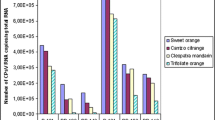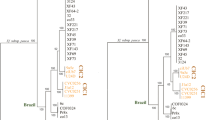Abstract
Huanglongbing (HLB), associated with the proteobacterium ‘Candidatus Liberibacter asiaticus’(CLa), is a destructive disease in citrus. Resistance/tolerance has been identified in some citrus species, wild relatives, and transgenic citrus genotypes. The objectives of this study were to: (1) evaluate the response of the citrus germplasm collection from Puerto Rico (namely ‘Rico’) to HLB, (2) determine the most appropriate rootstock-genotype combination, and (3) quantify the presence of the bacterium in the plant tissue by quantitative polymerase chain reaction (qPCR). Seventeen genotypes were grafted onto ‘HRS 812’ and ‘Swingle’ citrumelo rootstocks. The plants were inoculated with HLB infected buds and evaluated at 12 months after inoculation in a greenhouse in Adjuntas, Puerto Rico. The genotypes ‘Lares’ and ‘Padilla’ had significantly higher incidence (>65.0%) and severity (3.2–4.3) compared to ‘Mexican Lime’ and ‘Tahiti Lime’ that had lower scores (<18.0%, 1.1–1.3) using both rootstocks. In contrast, the genotypes ‘Fronton’, ‘PR-Sel-1’, and ‘Rico 7–376’ grafted on HRS 812; and ‘Pietri 334’ grafted on Swingle citrumelo had lower HLB incidence (<10%) and severity (<1.5). Significantly higher mean cycle threshold (Ct) values were only observed for the genotypes Fronton (37.0), Tahiti Lime (36.5), and Pietri 334 (36.2) compared to Padilla (34.7 and 32.7 when HRS 812 and Swingle citrumelo was used as rootstock, respectively). Citrus genotypes having lower HLB scores were identified, however, their reaction varied according to the rootstock used.

Similar content being viewed by others
References
Albrecht, U., & Bowman, K. D. (2011). Tolerance of the trifoliate citrus hybrid US-897 (Citrus reticulata Blanco x Poncirus trifoliata L. Raf.) to huanglongbing. Horticultural Science, 46, 16–22.
Albrecht, U., & Bowman, K. D. (2012). Tolerance of trifoliate citrus rootstock hybrids to Candidatus Liberibacter asiaticus. Scientia Horticulturae, 147, 71–80.
Albrecht, U., Fiehn, O., & Bowman, K. D. (2016). Metabolic variations in different citrus rootstock cultivars associated with different responses to huanglongbing. Plant Physiology and Biochemistry, 107, 33–44.
Alvarez, S., Rohrig, E., Solís, D., & Thomas, M. (2016). Citrus greening disease (Huanglongbing) in Florida: Economic impact, management and the potential for biological control. Agricultural Research, 5, 109–118.
Bassanezi, R., Belasque, J., & Montesino, L. (2013). Frequency of symptomatic trees removal in small citrus blocks on citrus huanglongbing epidemics. Crop Protection, 52, 72–77.
Bassanezi, R., Montesino, L., Godoy, M., Filho, A., & Amorim, L. (2011). Yield loss caused by huanglongbing in different sweet oranges in São Paulo, Brazil. European Journal of Plant Pathology, 130, 577–586.
Boava, L., Duarte, C., Critofani-Yali, M., & Machado, M. (2015). Incidence of ‘Candidatus Liberibacter asiaticus’-infected plants among citrandarins as rootstock and scion under field condition. Phytopathology, 105, 518–524.
Bowman, K. D., & Faulkner, L. (2016). New citrus rootstocks released by USDA 2001-2010: Field performance and nursery characteristics. Horticultural Science, 51, 1208–1214.
Bowman, K. D., & Rouse, R. E. (2006). US-812 citrus rootstock. Horticultural Science, 41, 832–836.
Cheema, S. S., Kapur, S. P., & Chohan, J. S. (1982). Evaluation of rough lemon strains and other rootstocks against greening-disease of citrus. Scientia Horticulturae, 18, 71–75.
ColBurn, G. C., & Graham, J. H. (2007). Protection of citrus rootstocks against Phytophthora spp. with a hypovirulent isolate of Phytophthora nicotianae. Phytopathology, 97, 958–963.
Cooke, B. M. (2006). Disease assessment and yield loss. In B. M. Cooke, D. G. Jones, & B. Kaye (Eds.), The epidemiology of plant diseases (pp. 43–74). Springer.
Dala-Paula, B. M., Plotto, A., Bai, J., Manthey, J. A., Baldwin, E. A., Ferrarezi, R. S., & Gloria, M. B. A. (2019). Effect of huanglongbing or greening disease on orange juice quality, a review. Frontiers in Plant Science, 9, 1–19.
Estévez de Jensen, C., Vitoreli, A., & Román, F. (2010). Citrus greening in commercial orchards in Puerto Rico. Phytopathology, 100, S34.
Folimonova, S. Y., & Achor, D. S. (2010). Early events of citrus greening (Huanglongbing) disease development at the ultrastructural level. Phytopathology, 100, 949–958.
Fujikawa, T., Miyata, S. I., & Iwanami, T. (2013). Convenient detection of the citrus greening (Huanglongbing) bacterium ‘Candidatus Liberibacter asiaticus’ by direct PCR from the midrib extract. PlosOne, 8, 1–7.
Gottwald, T., & Graham, J. (2014). Citrus diseases with global ramifications including citrus canker and huanglongbing. CAB Reviews, 9, 1–11.
Hall, D. G., Ramadugu, C., Hentz, M. G., Gmitter Jr., F. G., & Stover, E. (2019). Survey of Poncirus trifoliata hybrids for resistance to colonization by Asian citrus psyllid. Florida Entomologist, 102, 635–637.
Hoffman, M., Doud, S., Williams, L., Zhang, M., Ding, F., Stover, E., Hall, D., Zhang, S., Jones, L., Gooch, M., Fleites, L., Dixon, W., Gabriel, D., & Duan, Y. (2013). Heat treatment eliminates ‘Candidatus Liberibacter asiaticus’ from infected citrus trees under controlled conditions. Phytopathology, 13, 15–22.
Illumina Inc. (2012). Illumina/EcoStudy software User’s guide. Illumina Inc.
Intriago, L.D. (2019). Severidad de Huanglongbing en genotipos de naranja (Citrus sinensis), Mandarina (Citrus reticulata) y Limon (Citrus spp.) en huertos. MSc thesis, University of Puerto Rico, Mayagüez, Puerto Rico, 79 p.
Johnson, E. G., Wu, J., Bright, D. B., & Graham, J. H. (2014). Root loss on presymptomatic huanglongbing affected trees is preceded by Candidatus Liberibacter asiaticus root infection but not phloem plugging. Plant Pathology, 63, 290–298.
Li, W., Li, D., Twieg, E., Hartung, J. S., & Levy, L. (2008). Optimized quantification of unculturable Candidatus Liberibacter spp. in host plants using real-time PCR. Plant Disease, 92, 854–861.
McCollum, G., Hilf, M., Irey, M., Luo, W., & Gottwald, T. (2016). Susceptibility of sixteen citrus genotypes to ‘Candidatus Liberacter asiaticus’. Plant Disease, 100, 1080–1086.
Monzo, C., & Stansly, P. A. (2017). Economic injury levels for Asian citrus psyllid control in process oranges from mature trees with high incidence of huanglongbing. PlosOne, 12, 1–25.
Morgan, J. K., Zhou, L., Li, W., Shatters, R. G., Keremane, M., & Duan, Y. P. (2012). Improved real-time PCR detection of ‘Candidatus Liberibacter asiaticus’ from citrus and psyllid hosts by targeting the intragenic tandem-repeats of its prophage genes. Molecular and Cellular Probes, 26, 90–98.
Moscoso, C. G. (1958). The Puerto Rican chironja-new all-purpose citrus fruit. Economic Botany, 22, 87–94.
Ramadugu, C., Keremane, M., Halbert, S., Duan, Y., Roose, M., Stover, E., & Lee, R. (2016). Long term field evaluation reveals HLB resistance in Citrus relatives. Plant Disease, 100, 1858–1869.
Richardson, M. L., & Hall, D. G. (2013). Resistance of Poncirus and Citrus x Poncirus germplasm to the Asian citrus psyllid. Crop Science, 53, 183–188.
Román, F., & González, A. (2013). Liberación de los patrones de cítricas ‘Swingle citrumelo’, ‘carrizo’, y HRS 812 para Puerto Rico. The Journal of Agriculture of the University of Puerto Rico, 97, 101–106.
Román, F., González, A., & Macchiavelli, R. (2011). Producción y calidad de la china 'Hamlin' [Citrus sinensis (L.) Osb.] en cuatro patrones en tres localidades de Puerto Rico. The Journal of Agriculture of the University of Puerto Rico, 95, 25–34.
Román, F., González, A., Santana, O., & Rodríguez, R. (2009). Performance of chironja (clone 2-4) on five rootstocks after eight years of growth in two zones of Puerto Rico. The Journal of Agriculture of the University of Puerto Rico, 93, 187–193.
SAS Institute. (2012). SAS/STAT User’s guide. SAS Institute, Inc.
Stover, E., Hall, D. G., Grosser, J., Gruber, B., & Moore, G. A. (2018). Huanglongbing-related responses of ‘Valencia’ sweet orange on eight citrus rootstocks during greenhouse trials. HortTechnology, 28, 776–782.
Stover, E., Inch, S., Richardson, M. L., & Hall, D. G. (2016). Conventional citrus of some scion/rootstock combinations show field tolerance under high huanglongbing disease pressure. Horticultural Science, 51, 127–132.
Tirado, R., Rivera, D., Segarra, A., Román, E., & González, A. (2018). Performance of two citrus species grafted to different rootstocks in the presence of huanglongbing disease in Puerto Rico. Horticulturae, 4, 38.
Wang, N., Pierson, E. A., Setubal, J. C., Xu, J., Levy, J. G., Zhang, Y., Li, J., Rangel, L. T., & Martins Jr., J. (2017). The Candidatus Liberibacter-host interface: Insights into pathogenesis mechanisms and disease control. Annual Review of Phytopathology, 55, 451–482.
Acknowledgments
We thank the USA-NIFA-HATCH project for supporting the funds of this research. Authors also thank Mrs. Jennifer Pagán, Casiani Soto, and Yanira Miranda; and Mr. Luis Cabán for the support in the greenhouse work; and Dr. James Beaver for reviewing the manuscript and his valuable inputs.
Author information
Authors and Affiliations
Corresponding author
Ethics declarations
Human and animal studies
This article does not contain any study with human participants or animals performed by the authors.
Conflict of interest
The authors declare that there is no conflict of interest.
Rights and permissions
About this article
Cite this article
Viteri, D.M., Estévez de Jensen, C. & Hernández, E. Response of Citrus spp. germplasm from Puerto Rico grafted on two rootstocks to early infection of huanglongbing. Eur J Plant Pathol 160, 589–597 (2021). https://doi.org/10.1007/s10658-021-02267-y
Accepted:
Published:
Issue Date:
DOI: https://doi.org/10.1007/s10658-021-02267-y




